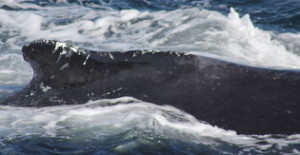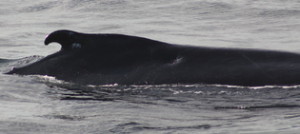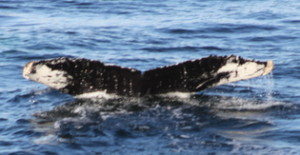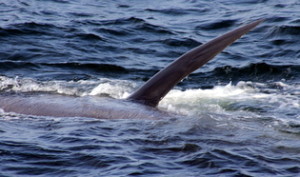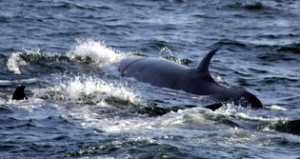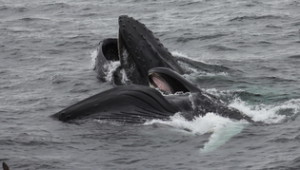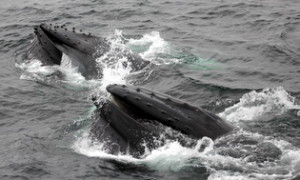October 17 to October 27
On October 17th we found Rune and Glo slowly working their way to the southeast. Pleasant breezes between 11 and 16 knots kept a nice bounce on the water, while sunny skies made our two trips today quite enjoyable. As the days get shorter, we are seeing fewer and fewer humpback whales, as many of them prepare to make their way down south to their winter home in the West Indies and the Caribbean. Their departure from the Gulf of Maine can be as early as October and as late as December, with some juveniles sticking it out for the winter, saving precious energy and occasionally finding a patch of food here in the winter.
Once humpbacks have set forth on their migratory route, they are thought to head straight for their wintering grounds, rather than meandering or stopping along the way. Scientists studying humpback migrations in the southern hemisphere recently found that individual humpbacks will maintain a constant course over 200km , sometimes not stopping for several days!
Despite the calm seas and great visibility on October 18th, we weren’t able to find whales until the afternoon, when we finally located Salt and Nile to the north of the BE Buoy. The BE Buoy is one of the buoys marking the shipping lanes into Boston harbor. The entrance to the shipping lane is designated as BA, with the letters moving sequentially through the alphabet approaching the harbor. The shipping lanes were recently shifted northward in order to accommodate a seasonal “hotspot” of cetaceans in Stellwagen Bank, and this shift will hopefully reduce the number of shipstrikes that threaten our already fragile population of large whales.
Near the base of Nile’s dorsal fin, we could just barely see a scar left behind by a tagging study done earlier this summer. The tag has long since fallen off, but that fact in and of itself has provided scientists with important information. The tagging study this summer was carried out by scientists from Australian Antarctic Division, Cascadia Research Collective, The Marine Mammal Center, the National Marine Mammal Laboratory, and the Provincetown Center for Coastal Studies as part of a pilot project to test the longevity and impact of a new tagging technology. Nile’s tag transmitted data for 28 consecutive days! More information on the project and a map containing information on all of the tagged whales can be found here.
After a few days of wind, we were eager to head back offshore on October 22nd. As we left the harbor, we watched the double crested cormorants on the breakwater drying their wings between dives, and noticed that there was a larger, lighter bird among the black-winged waterfowl we are so used to seeing perched on the rocks. We grabbed our binoculars and saw that it was a great blue heron sitting atop the rock wall!
After not having much luck with whales on our morning’s trip, we headed to the north, rather than to the east on our afternoon trip. We headed so far offshore that land was barely visible, and finally found Salt, the true grande dame of Stellwagen Bank. Salt was surfacing reliably every 12 minutes, and at one point she even surfaced right under the bow!
We had another long ride on October 23rd, but this time had a bit more luck. We ended up 22 miles to the northeast of Race Point with calm seas on our side, and here we found four humpback whales as well as one sei whale. Sei whales, like the North Atlantic right whales so common in our waters in the spring, feed largely on copepods and another types of zooplankton. Being low on the food web, copepods are rich in usable energy and contain an oil rich sac that is orange in color. A late-stage Calanus finmarchicus is only slightly smaller than a grain of rice, and is about two calories.
Among the humpbacks spotted today was Follicle. Follicle is a female first seen in 1998. She had her first known calf in 2009. To date, this calf is without a name.
On October 24th, mostly cloudy skies and flat seas accompanied us out nearly as far out as Wildcat Knoll, to the east of Stellwagen Bank. Here, the passengers were treated to sightings of a single humpback, and at least 25 feeding sei whales! These quick, sleek, mysticetes were lunging on their sides through huge swarms of krill, almost resembling a tadpole as they rolled to their sides, ventral pleats bulging.
The waters were soon red with krill, as well as with the defecation from a few of the feeding whales. Krill are about an inch long, resemble shrimp, and are often bright red in color, making them easily distinguishable at the surface.
Especially compared to the well-studied humpback whale, little is known about the range and migratory patterns of the sei whale. Much of what we know about these animals comes from whaling records, and as such, there is no good estimate of their population in the North Atlantic.
The seas picked up dramatically overnight and on October 25th, we only attempted one trip in the afternoon. Despite the rough seas, we managed to get a few great looks at the two Minke whales that have been reliably hanging around in Cape Cod Bay, just off of Wood End Lighthouse. Our initial course was towards the southwest corner of Stellwagen Bank, as battling the east wind to go back to Wildcat Knoll would have made for quite an unpleasant trip. Luckily, our keen-eyed captain Todd was able to spot a fin whale from three miles away. This is quite a feat considering that these elusive animals often keep a very low profile! Although we only got a quick look, it surfaced right under the bow, giving all of our passengers a great look at this gigantic animal!
Also keeping our attention during our wait for the whale were the dozens of diving gannets plunging into the ocean all around the boat. These pelagic birds have wing spans of around 6 feet, and dive headfirst into the water — creating a great splash — whenever they spot a fish.
It rained overnight, but cleared up by October 26th, and we anticipated another long ride offshore. Luckily, the seas were calm, and we were prepared. We were also lucky that we had one of our best whale spotters on board. Our first mate, Lacey, spotted spouts from miles away, and when we arrived on scene, we found over 13 humpback whales lunging and gulp feeding away!
There were many Great shearwaters with the whales. These birds feed on the same small fish that the whales are after, and like the whales, spend the summer bulking up for their long migration south. These birds travel even farther than the humpbacks, nesting and breeding in the southern hemisphere. These gull-sized birds could be seen swooping and diving beneath the bubbles that the whales were generating to aggregate the fish.
We were especially excited to see Thalassa and Habenero in this mix. These two whales are the offspring of two female humpbacks, Salt and Pepper, respectively, who were often seen associating with one another in the mid 1970s! They still return to the waters of the Gulf of Maine to feed.
On October 27th, the gray skies and rain couldn’t mask the raucous bird activity happening both near shore and out towards the triangle. Mature and immature gannets, double-crested cormorants, common terns, several species of shearwaters and gulls, and even a northern fulmar, were all competing for schooling fish. The high winds and big seas also didn’t stop us from seeing two huge humpbacks breaching in the distance. The action didn’t stop as the Dolphin VIII approached these two active humpback whales. Upon our arrival, they expressed curiosity about our vessel, approaching and then diving under the bow.
Today, we marked the close of the 37th season. The cold winds of fall make it increasingly difficult to get good whale watching trips in, and so we’re closing up shop until the spring. This season included an incredible spring, with dozens of right whales and sei whales feeding in the bay, followed by a summer of feeding humpbacks, amazing sightings of humpbacks and minkes, followed by a blue whale and even some long-finned pilot whales in the fall. We can’t wait to see what 2012 has in store for us! See you then!







